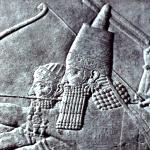
The Near East

Storytelling, the Meaning of Life, and The Epic of Gilgamesh
Famous Near Eastern Rulers Quiz
. . .
From the Near East comes the Old Babylonian account of the life and death of GILGAMESH. There was a real Gilgamesh, a king who ruled some 2700 years before Christ lived and the Romans consolidated their vast empire. The character and the exploits of this king were preserved in the form of stories that circulated for many years after the king's death. Some of these tales -- more than 600 years after Gilgamesh's rule -- were collected by a story teller and were put down in the form of an epic poem. This poem is what we know today as The Epic of Gilgamesh.
Who knows how many versions The Epic of Gilgamesh went through before consolidation in its written form? Who knows how many translations the stories underwent before their reworking in the Babylonian language? Who knows how many parts of the story might have offended or misrepresented the eponymous king? Who knows how many story-tellers made more (or less) of Mashu, the mountainous gateway to the other world, as they kept their audiences spellbound with fantastical details of this greatest of human adventures -- the struggle to find (and retain) eternal life?
What is known is no less intriguing. How curious is the parallel between the story of Utnapishtim and the Hebrew account of Noah. How symbolic is the description of Enkidu, the prototypical natural man, as he sheds his animalistic behaviors in preference for the pleasures of human society. How extraordinary is the description of the snake, whose stealing of the essence of immortality from Gilgamesh results in the snake's rebirth each time it sheds its skin.
Of course the Hebrew iteration of the Flood story is not coincidence. For a time, the HEBREWS lived in SUMER, home to Abraham's people. Nomadic people, they left the fertile river valleys and headed for CANAAN and later EGYPT, taking with them ancient accounts of floods and righteous people whose obedience and wisdom helped them to survive the consuming waters.
Nor is the function of the snake coincidental either. The Hebrews find the powerful, mysterious serpent in their creation story and the Garden of Eden, which surely was located in the Tigris-Euphrates river valley, not the dry vistas of Canaan or the arid Sinai peninsula. But while, for the Sumerians, the snake is merely deceitful and clever, the snake becomes the symbol of creeping evil for the Hebrews. [Next]
Home | Near East | India | Egypt | China | Greece | Rome | Islam | Europe | Conclusions
Computer Services Provided by the University of Evansville.
Copyright © 1997. Exploring Ancient World Cultures.